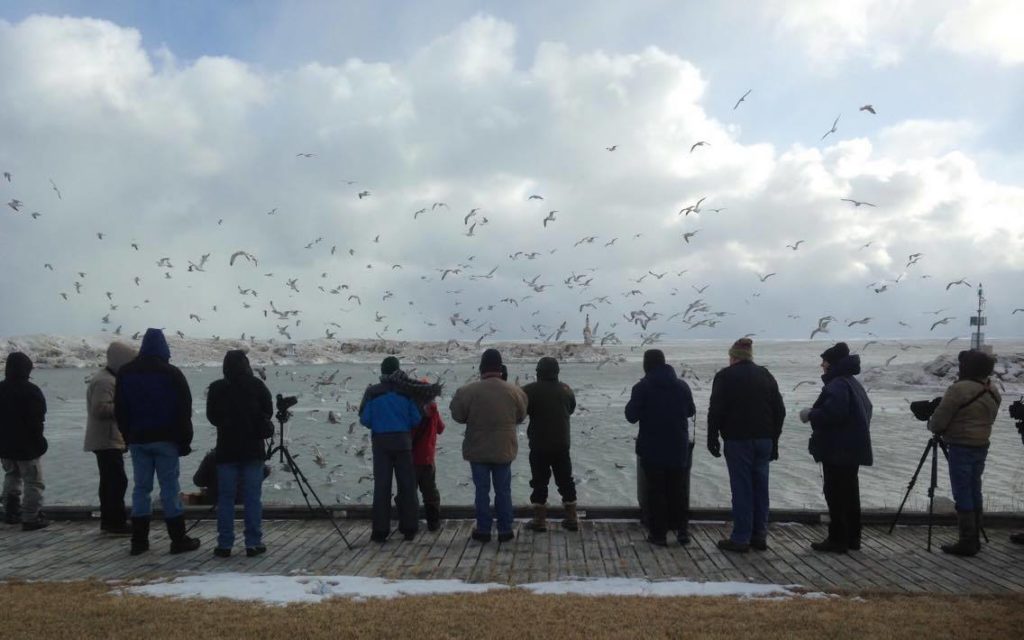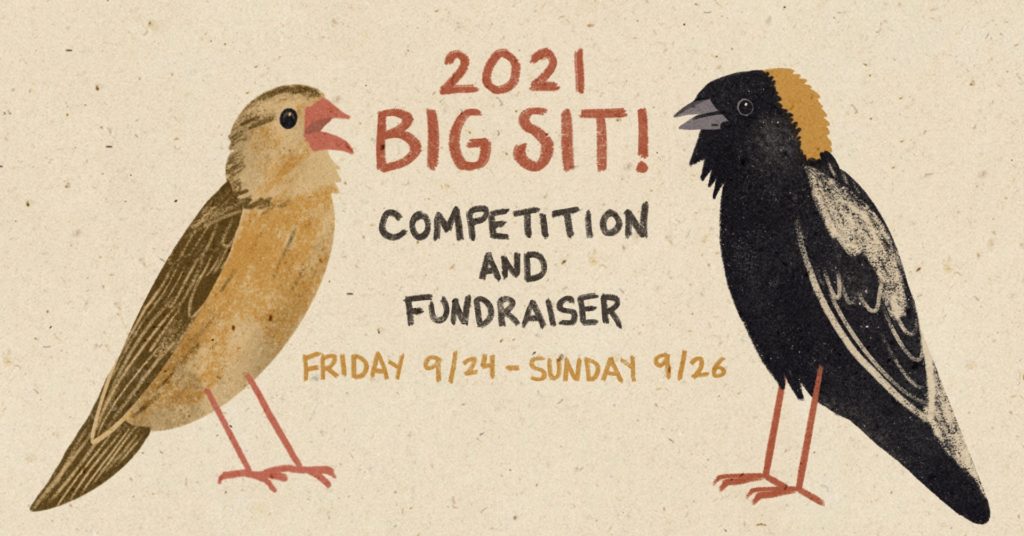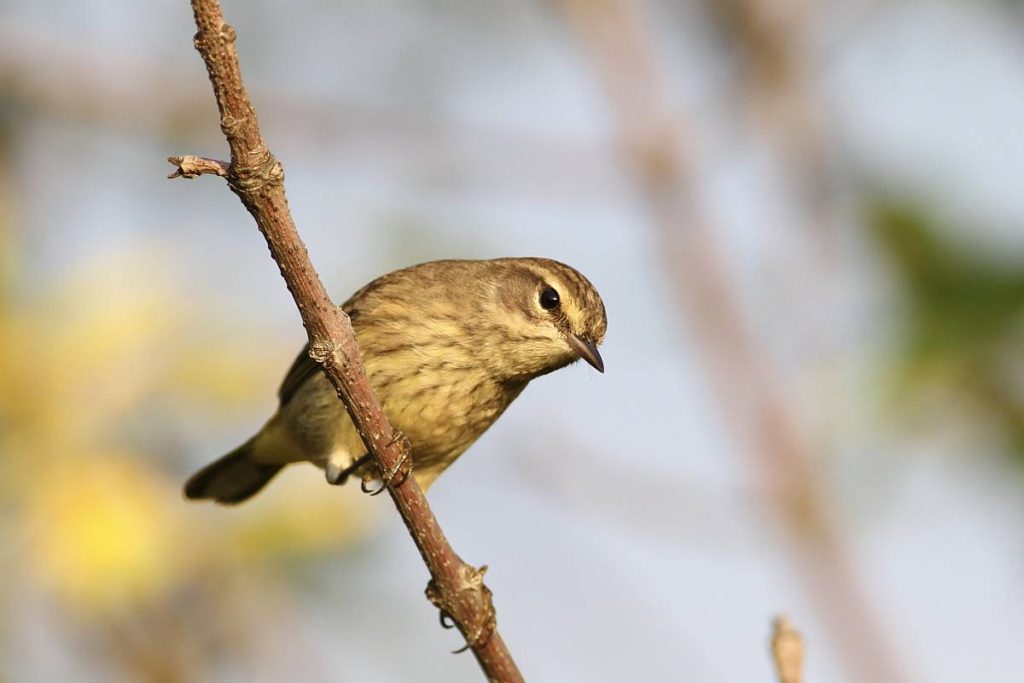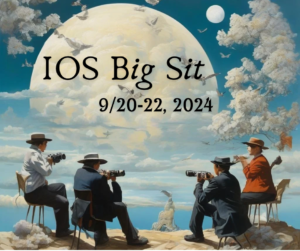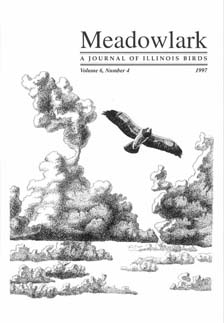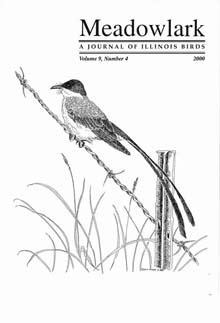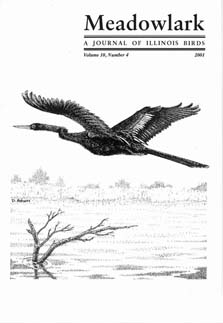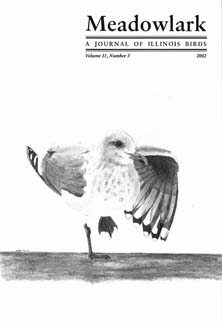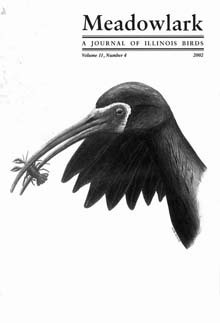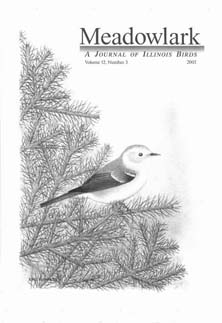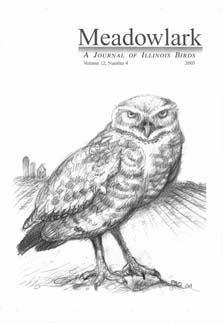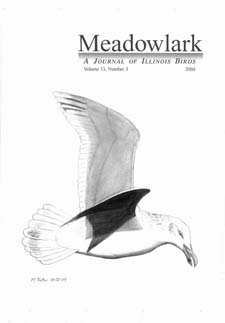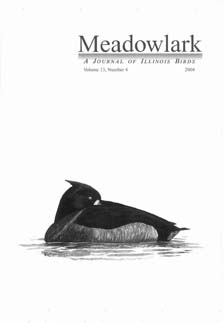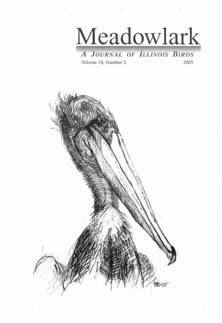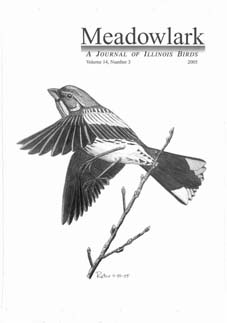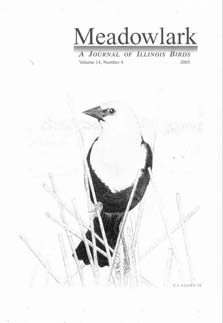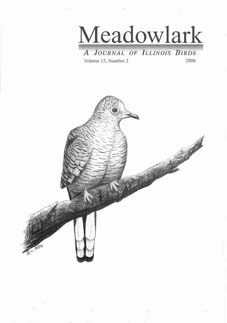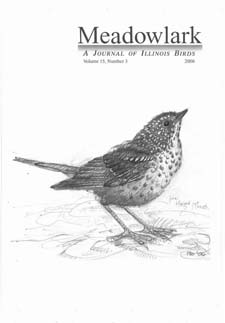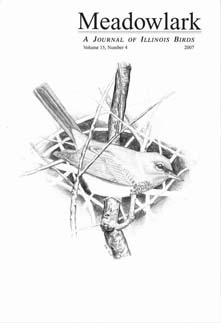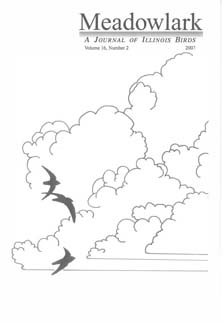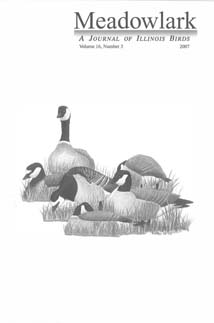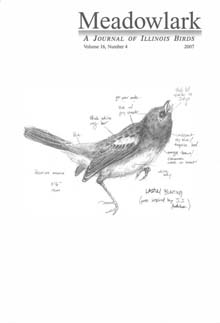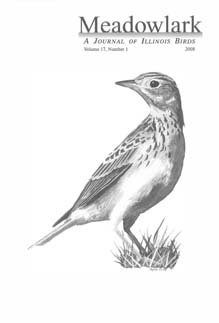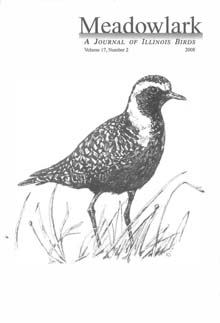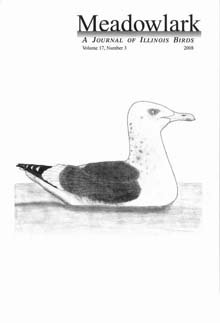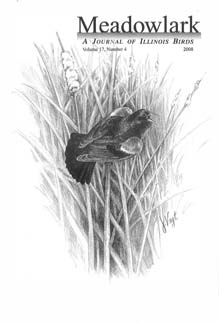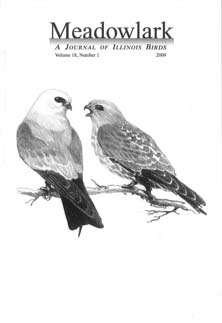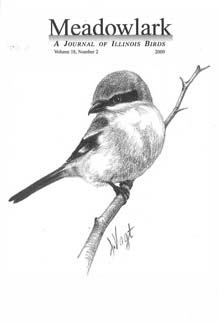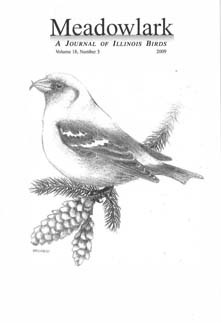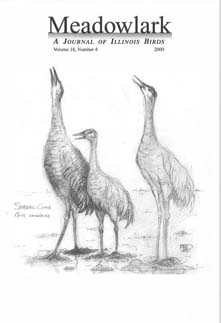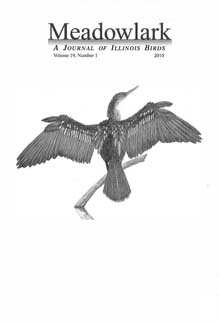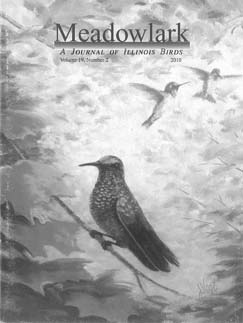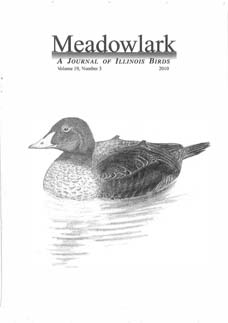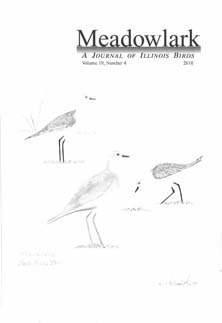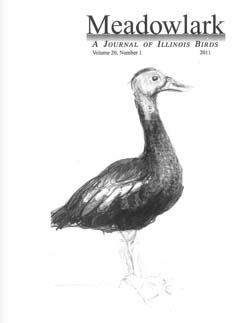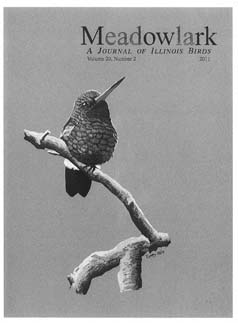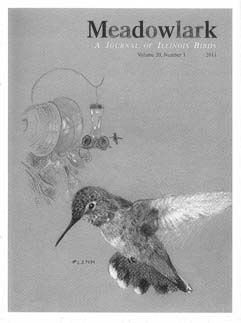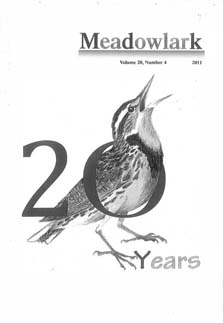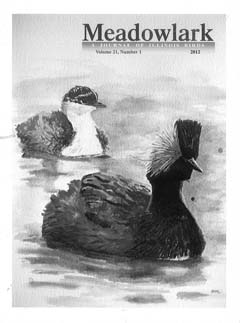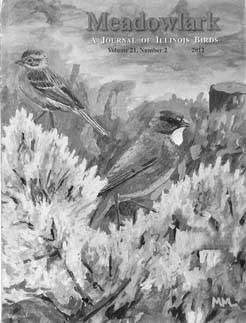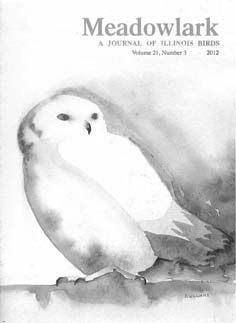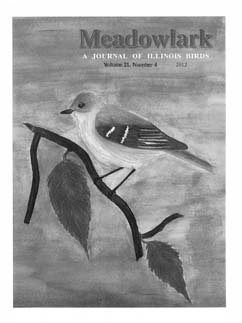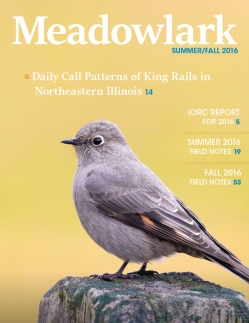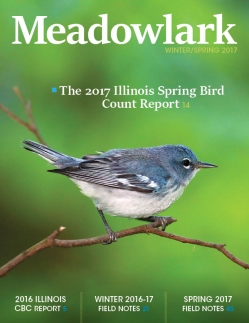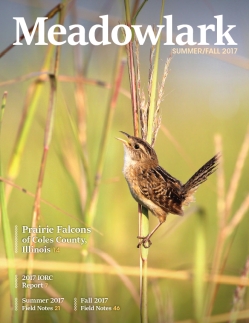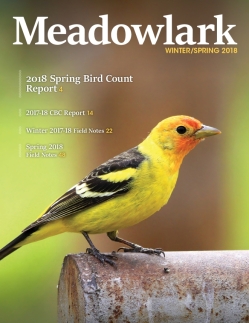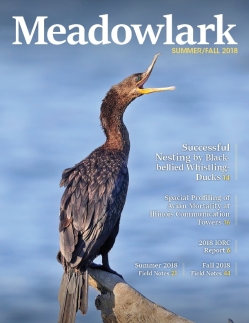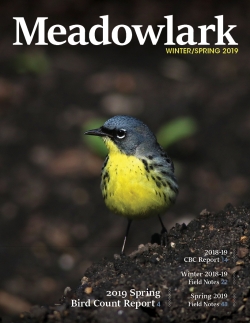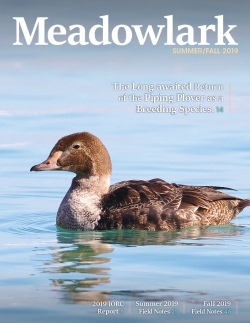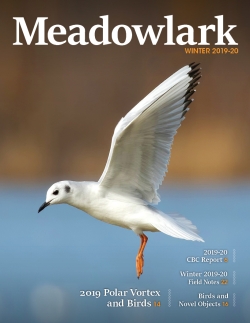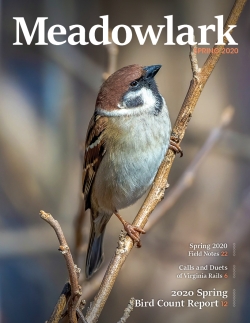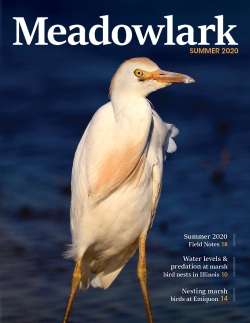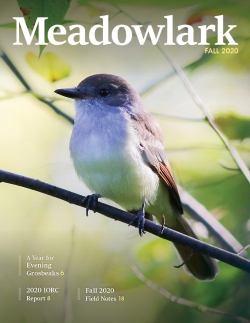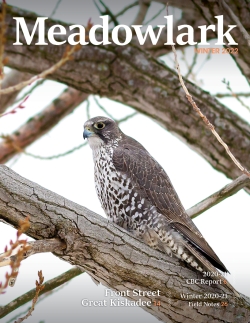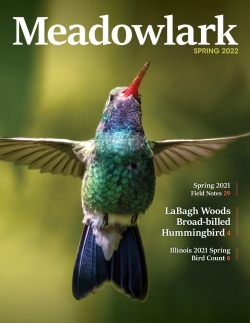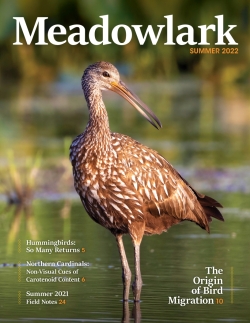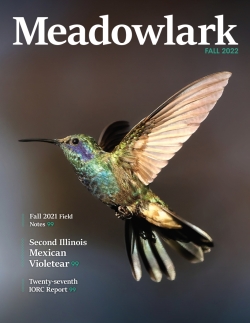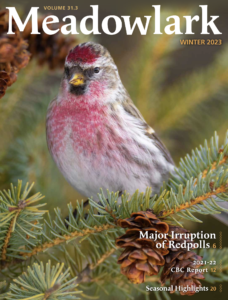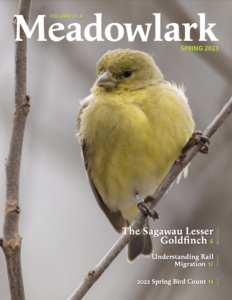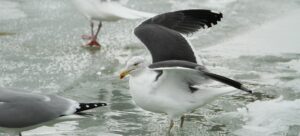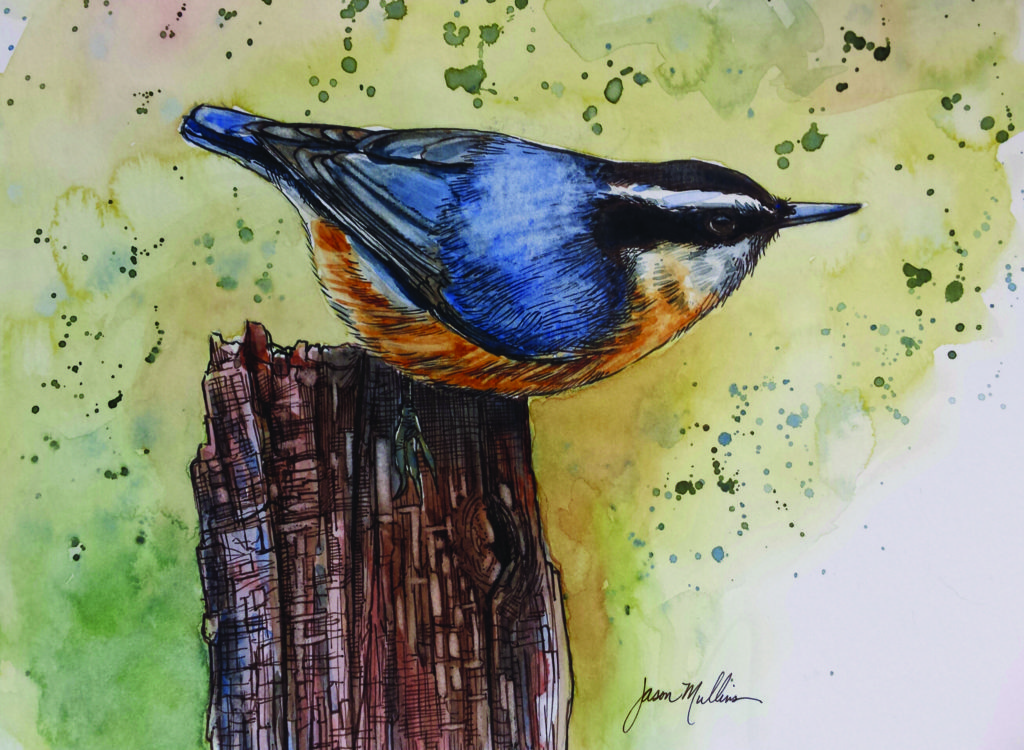
Drawing above of Red-breasted Nuthatch by Jason Mullins.
The Meadowlark Page Index is a full index of every issue of Meadowlark including a quick view of every cover and quick links to specific pages in the journal.
Use the Meadowlark Species Index to search for and display every page in Meadowlark with a reference to a specific species.
Index of Published Articles
The following is a list of articles published in Meadowlark over the past 24 years. The latest issue is at the bottom of this list.
Volume 1
#1 – Premiere issue The Des Plaines River Wetlands Demonstration Project; A bird finding guide to shorebirds in southern Illinois.
#2 – Where, when, and how to watch hawks.
#3 – Snowy Owl invasion; The rare wintering Ivory Gull.
#4 – Spring Bird Count; bird rehabilitation.
Volume 2
#1 – Grassland bird population changes in Illinois and neotropical migrants studies.
#2 – The status of Chicago’s Peregrine Release and Restoration Project.
#3 – The status of Bald Eagles in Illinois.
#4 – The Greater Prairie-Chicken in Illinois; The first confirmed state record of the Painted Bunting.
Volume 3
#1 – The changing role of bird banding in Illinois and the nation.
#2 – Rufous Hummingbird records and gull identification.
#3 – Christmas Bird Counts, how useful are they?
#4 – How many birds die due to skyscrapers and other urban death traps?
Volume 4
#1 – The relationship between songbird breeding success and small mammal abundance, and an exciting new breeding bird hotspot.
#2 – Illinois’ endangered and threatened birds.
#3 – A Christmas Bird Count compiler goes on nine CBC’s in less than two weeks.
#4 – The biology and ecology of heronries.
Volume 5
#1 – The status of the House Finch in Illinois and how its presence affects the House Sparrow.
#2 – Chicago Lakefront Birding.
#3 – The role of habitat in the breeding and migratory success of wetland birds, plus a look at a rare ephemeral wetland in central Illinois.
#4 – The average arrival dates of all your favorite migrants in eastern Illinois and three other Midwestern sites.
Volume 6
#1 – Our fifth anniversary issue helps you update your field guides and life lists to reflect the current changes in species designations in North American birds.
#2 – Details on birds parasitized by the Brown-headed Cowbird.
#3 – Christmas Bird Count and Band-tailed Pigeon records.
#4 – Illinois Spring Bird Count results are featured plus an article on the state’s first Gull-billed Tern (Sterna nilotica).
Volume 7
#1 – Sabine’s Gull in the Middlewestern Prairie Region
#2 – Are Breeding Herons and Egrets Deserting the Central Illinois River Floodplain?
#3 – Featured article on Eastern Bird Populations in Dupage County and the 1997 Christmas Bird Count.
#4 – The 1998 Spring Bird Count results and the first of the series on Avian Studies in Illinois.
Volume 8
#1 – A series of featured articles on various species of interest breeding in Illinois including: Monk Parakeet, Osprey, Mississippi Kite, Bewick’s Wren, Purple Gallinule, and Common Terns.
#2 – A series of featured articles on the first Illinois Records of the Black Skimmer, Allen’s Hummingbird, and White-winged Dove.
#3 – Potential effects of increased predation risk on nestling House Wren quality and survival.
#4 – A series of articles on state records for the following species: Gray Kingbird, Tropical/Couch’s Kingbird, Garganey, Painted Bunting.
Volume 9
#1 – An excellent series of sight and nesting records for a variety of species including such species as Black-necked Stilt and Western Kingbird.
#2 – A look at the historical and rare birding in the state.
#3 – Explore some Illinois “firsts” and the widespread invasion of Northern Shrikes.
#4 – Highlights include the 2000 spring bird count and migrations records.
Volume 10
#1 – For the first time in history, the Painted Bunting has become a confirmed breeder in Illinois.
#2 – Dr. Steven Havera looks at the effects of land practices on waterfowl in Illinois, and the federally endangered Red-cockaded Woodpecker visits Illinois Beach State Park.
#3 – Learn about Illinois’ first confirmed records of Long-tailed Jaeger, and the interesting behaviors this bird exhibited for many observers.
#4 – This issue features the 2001 spring bird count as well as the status of jaegers in Illinois.
Volume 11
#1 – Our tenth anniversary issue features articles on Illinois’ first reported Scissor-tailed Flycatcher nest as well as an Arctic Tern attempt at breeding with a Common Tern and the first documented record of nesting Ring-billed Gulls on a rooftop in Illinois.
#2 – White-throated Sparrows have been documented for the first time as nesting in Illinois. Plus, read about the new hawk watch at Illinois Beach State Park.
#3 – Illinois volunteers work to save habitat and document avian population trends, an American Robin nests in Chicago in December, and the Illinois 2001 Christmas Bird Counts.
#4 – Report on Chicagoland’s first spring migration bird banding station, the population decline of the Red-headed Wodpecker in Wisconsin and Illinois, and a pair of Cinnamon Teal in Clinton County.
Volume 12
#1 – Whooping Cranes over Illinois, the status of the Common Tern in Illinois, and introducing children to birding.
#2 – An estimate of shorebird numbers in Illinois, the status of the Whimbrel in the Middlewestern prairie region, and the status of the Piping Plover on the Great Lakes. Also, a guide to birding sod fields.
#3 – Winter bird population changes during a 38-year period in an urbanizing region, Illinois’ first Hermit Warbler, the 2002/2003 Illinois Christmas Bird Count, and a bird finding guide to the Paul Douglas Forest Preserve.
#4 – The effect of temperature and food choice of birds at feeders in northeastern Illinois, Burrowing Owl in Chaimpaign County, and the 2003 Illinois Spring Bird Count.
Volume 13
#1 – The potential impact of climate change on the summer distribution of Illinois’ nongame birds, first Illinois record of Roseate Spoonbill, Eurasian Collared-Doves in a River Forest backyard, and nesting Lark Sparrows in DuPage County.
#2 – This issue features the status of wintering Bald Eagles in central Illinois, a wonderful photo gallery of shorebirds and an account of the
first Illinois and second inland North American record of Black-tailed Gull.
#3 – Features Extreme birding by Kelly McKay, the 20023/2004 Christmas Bird Count and photos from the Gull Frolic and the Rough-legged Hawk invasion.
#4 – Mottled Duck at Lake Springfield, first state record by H. Davd Bohlen, plus an article about Audubon’s Washington Eagle — did it really exist —
written by Scott Maruna.
Volume 14
#1 – Features Monk Parakeets in Illinois – their history, the present and the future, written by Walter Marcisz and stories about interesting nesting
occurrences in the state last summer.
#2 – Nesting Swainson’s Hawks in Illinois, observations of a Hairy Woodpecker pair in a River Forest backyard, and a variety of rarities from around the state.
#3 – The Illinois prairie-chicken recovery plan, hawkwatching at Illinois Beach State Park, the Kane County Lark Bunting, and the 2004/2005 Christmas Bird Count. Corrected charts for the article on hawkwatching at Illinois Beach State Park can be found here.
#4 – Illinois’ important bird areas, Illinois’ first Fork-tailed Flycatcher, and the statewide Spring Bird Count.
Volume 15
#1 – Arrival dates and recapture patterns of spring migrant songbirds in northeasten Illinois, Bald Eagles attempting to nest in Kane County, and Field Notes for the 2005 breeding season.
#2 – First state record of Inca Dove, a Sooty Tern specimen from Illinois, Lost Mound Unit of the Upper Mississippi River National Wildlife and Fish Refuge, and the twelth report of the Illinois Ornithological Records Committee.
#3 – The love song of Catharus guttatus, a juvenile Hermit Thrush in Chicago, the 1978 Chicago Ross’s Gull, a photo essay of Bald Eagles in winter, the 2005/2006 Illinois Christmas Bird Count, and Field Notes for the 2005/2006 winter season.
#4 – A second state record of MacGillivray’s Warbler in Kane County, a Yellow-throated Warbler at a Vermilion County feeder, reflections on backyard birding throughout Illinois, and the 2006 Illinois spring bird count.
Volume 16
#1 – Trumpeter Swans in Illinois, observations of nesting Red-headed Woodpeckers in Cook County, reflections on backyard birding throughout Illinois, and the 2006 breeding season.
#2 – Late Chimney Swifts, Swainson’s Hawks at the Illinois Beach State Park Hawkwatch, In Memorium, the Thirteenth report of the Illinois Ornithological Records Committee, and more.
#3 – A Barnacle Goose in LaSalle County, little-known birding spots in Jackson County, Black-headed Gull at Montrose, the 2006/2007 Christmas bird count, and Field Notes for the 2006/2007 winter season.
#4 – Census methods to better understand the nightly passage of songbird migrants through the Chicago region during May, a Summer Tanager visits a jelly feeder in DuPage County, the 2007 Illinois Statewide Spring Bird count, and Field Notes for the 2007 spring migration season.
Volume 17
#1 – On the hunt for Sprague’s Pipit, IOS research grants, reflections on backyard birding throughout Illinois, and the 2007 breeding season field notes.
#2 – The Plover Project, the Fourteenth Report of the Illinois Ornithological Records Committee, reflections on backyard birding throughout Illinois, and Field Notes for the 2007 fall migration.
#3 – Carlyle Lake gulls, a potential “Kamchatka” Mew Gull, sea ducks in central Illinois, the 2007/2008 Illinois Christmas Bird Count, 2007/2008 winter field notes, and more.
#4 – Illinois breeding bird population trends, a bird finding guide to Boone County, the 2008 Illinois Spring Bird Count, and Field Notes for the 2008 spring migration season.
Volume 18
#1 – Birdnotes from a bygone era, Mississippi Kites nesting in Rockford, and field notes for the 2008 breeding season.
#2 – IOS research grant awards, changes to the list of threatened and endangered Illinois birds, Yellow-breasted Chat study, backyard birding throughout Illinois, and the 2008 fall migration field notes.
#3 – Winter gull identification challenges, the fifteenth report of the Illinois Ornithological Records Committee, the 2008/2009 CBC season, remembering Laurence Binford and L. Barrie Hunt, and field notes for the 2008/2009 winter season.
#4 – Sandhill Crane colt survival in northeastern Illinois, aggressive interaction between a Sora and Virginia Rail during spring migration, the 2009 Illinois Statewide Spring Bird Count, and field notes for the 2009 spring migration.
Volume 19
#1 – Potential nesting Swainson’s Warbler in southern Illinois; First documented nesting record for Anhinga in Illinois; Northern Rough-winged Swallow builds nest in air-conditioning ducts, and more.
#2 – Effects of linear, woody vegetation removal of grassland birds at Bartle Grasslands; IOS awards six research grants; and more
#3 – Golden Eagle attacks white tailed deer at Nachusa Grasslands: Rat predation by a Black-crowned Night-Heron; and more
#4 – Chickamouse: Probable hybridization between Tufted Titmouse and Black-capped Chickadee in DeWitt County; Brown Creeper’s migratory route fidelity and urban fatality; the 2010 Illinois Statewide Spring Bird Count; Field Notes: Spring migration 2010
Volume 20
#1 – Status of the Barn Owl in Illinois; Social behavior in Red-headed Woodpeckers; Field Notes: The 2010 Breeding Season
#2 – Impacts of habitat restoration on songbirds in Chicago area forest preserves: Preliminary results from the 2010 breeding season; Red-eyed Vireo’s migratory route fidelity in an urban environment; The 2010/2011 Illinois Christmas Bird Count; Field Notes: The 2010 fall migration
#3 – Anna’s Hummingbird: Illinois’ first record; Inbreeding of Illinois Peregrine Falcons; IOS awards seven research grants; The 2011 Illinois Spring Bird Count Report; Field Notes: The 2010/2011 winter season
#4 – Illinois Ornithological Society celebrates 20 years; an avian census of Lowell Park
Volume 21
#1 -The Bobolinking Project: Experiments in Field Ornithology, Bohm Woods and the SIUE Nature Preserve: Valuable conservation assets for southwestern Illinois; Birding the Jane Addams Trail in Northwestern Illinois; Photo Essays: Peregrine Falcons nest at St. Michael Church; Sandhill Cranes attempt nesting in central Illinois; Field Notes: The 2011 breeding season
#2 -Does body condition explain patterns of songbird density in response to urbanization; Seventeenth report of the Illinois Ornithological Records Committee; Field Notes: The 2001 fall migration;Photo Gallery: Fall Birds of Illinois
#3 – A sampling of Snowy Owl pellet contents’ Illinois’ record irruption of Snowy Owls during the winter of 2011/2012 with notes on historical distribution; Gallery: A Snowy Owl extravaganza; The 20122/2012 Christmas Bird Count; Field Notes: Witner season 2011/2012
#4 – Elaeniamania; Illinois’ first winter record of the Black-throated Blue Warbler at sapsucker wells with notes on other Midwest and Mid-Canada records;Photo Gallery: Spring Birds; The 2012 Illinois Statewide Spring Bird Count; Field Notes: The 2012 spring migration
Volume 22
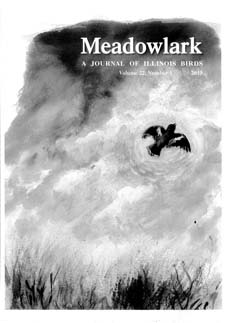
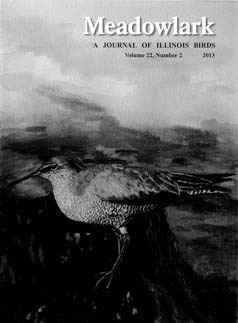
#1 – An integrative approach in testing density effects in a migratory songbird; The Prothonotary Warbler; Photo Gallery: Summer Color and Nesting Behavior; Field Notes: The 2012 breeding season
#2 – The 2012 Illinois and Mississippi River Fall waterbird and wetland habitat report; First Illinois record: The Wandering Tattler; Eighteenth report of the Illinois Ornithological Records Committee; Photo Gallery: Fall Migration; Field Notes: The 2012 fall migration
#3 – How to have a GR-EIGHT owling day (and night) by Jeff Smith; In Memoriam: Illinois birding community mourns the loss of three influential birders; 2013 IOS grants program sets records; The 2012/2013 Christmas Bird Count by Paul Sweet; Photo Gallery: Winter Beauties; Field Notes: The 2012/2013 Winter Season by Kelly McKay and Steven D. Bailey
#4 – Mute Swans: Potential impacts to wetlands and waterfowl in Illinois by Mike Eicholz; An invasion of Chipping Sparrows in spring by David B. Johnson; A Book Review: “Silent Spring Revisited” by Conor Mark Jameson by Stacia Novy; The 2013 Illinois Statewide Spring Bird Count; Field Notes: The 2013 spring migration
Volume 23
#1 – Lead shot ingestion rate and effects in Mourning Doves by Stephanice C. Plautz, Richard S. Halbook and Donald W. Sparling; In Memoriam: Jack Pomatto and Muriel Smith; Field Notes: The 2013 Breeding Season by Steven D. Bailey; Photo Gallery: Illinois Breeding Birds & Young
#2 – Characteristics of recently used or reused Red-headed Woodpecker cavity nests in Cook County, IL by Elsa C. Anderson and Jalene M. L Montagne; Museum sleuthing reveals the first Western Flycatcher for Illinois by Joshua I. Engle and Dave Willard; Illinois’ Second Gray Kingbird by Bob Shelby and Leroy Harrison; Nineteenth Report of the Illinois Ornithological Records Committee by Paul Sweet and Geoffrey Williamson; The 2013 Fall Migration Season by David B. Johnson
#3 – An unusual winter roosting shelter constructed by a Carolina Wren in central Illinios with commentary on winter survival on the edge by Lauren E. Brown and Evan S. Brown; Wintering first-cycle California Gull moves between two southern Illinois reservoirs by Dan Kassebaum; IOS supports birding lessons at Camp Casper by Christie Trifone Simon; The 2013/2014 Christmas Bird Count by Paul Sweet; Photo Galleries: Winter Gulls and Another Snowy Owl Invasion; Field Notes; The 2013/2014 Winter Season by Michael Hogg and David B. Johnson
#4 – Occupancy and turnover dynamics of grassland birds on private lands of Illinois as affected by habitat and field management by Justin J. Shew, Clayton K. Nielsen and Donald W. Sparling; The 2014 Illinois Spring Bird Count Report by Michael P. Ward and Tara Beveroth; Field Notes: The 2014 Spring Migration by Geoffrey A. Williamson; Photo Gallery: Spring Colors
Volume 24
#1 – Curve-billed Thrasher visits Montrose: Illinois’ second record by Luis Munoz; The value of urban grasslands for grassland birds in Northeast Illinois by Valerie L. Buxton and Thomas J. Benson; Breeding Season 2014 Field Notes by Steven D. Bailey; Photo Galleries Avian Colors of Summer Evidence of Illinois Breeders
#2 – Video cameras reveal diverse nest predator communities within Illinois’ shrublands by Scott J. Chiavacci, Thomas J. Benson and Michael P. Ward; The Diet of Chicago’s Celebrity South Loop Owls by Nandu Dubey and Josh Engel; the Twentieth Report of the Illinois Ornithological Records Committee by Paul W. Sweet and Geoffrey A. Williamson; The 2014 Fall Migration Season by David B. Johnson
#3 – The diet of Chicago’s celebrity south loop owls by Nandu Dubey and Joshua I. Engel; White Diamond in Quincy: states’ first well-documented adult Ivory Gull by Jason Mullins: Examining the role of migratory songbirds in the spread of Lyme disease in Illinios, Sarah Schneider, Christine Parker and James Miller.
#4 – Lincoln Land Community College bird banding station report and results by Vernon Kleen; the 2015 Illinois statewide spring bird count by Michael P. Ward and Tara Beveroth
Volume 25
#1 – Effects of added social information on habitat selection for grassland birds in central Illinois by John E. Andrews; Concealment of a nest and roosting shelter of the Carolina Wren by Evan S. Brown and Lauren E. Brown; Sora breeds successfully in Coles County agricultural field by Tyler D. Funk
#2 –
#3 –
#4 –
Volume 26
#1-#2 – Daily call patterns of King Rails in northeastern Illinois revealed by autonomous recording units by Daniel L. Goldberg and Toby A. Bassingthwaite; Twenty-Second Report of the Illinois Ornithological Records Committee by Geoffrey A. Williamson; Field Notes: The Summer 2016 Breeding Season by Steven D. Bailey, introduction by Jill S. Anderson; Field Notes: The Fall 2016 Migration Season by David B. Johnson
#3-#4 – 2016 Illinois Christmas Bird Count report by Paul Sweet; 2017 Illinois Spring Bird Count report by Michael P. Ward and Tara Beveroth; Field Notes: The Winter 2016-2017 Season by Daniel T. Williams Jr.; Field Notes: The Spring 2017 Migration Season by Geoffrey A. Williamson
Volume 27
#1-#2 – Twenty-Third Report of the Illinois Ornithological Records Committee by Geoffrey A. Williamson; Photo Gallery: 2017 Photo Highlights; Prairie Falcons of Coles County, Illinois by Tyler D. Funk; Field Notes: The Summer 2017 Breeding Season by Matt Hayes, assistant editing by Laura Reisse, Eric Secker, Tamima Itani, Adam Sell; Field Notes: The Fall 2017 Migration Season by Jill S. Anderson, assistant editing by David B. Johnson
#3-#4 – 2018 Illinois Spring Bird Count report by Tara Beveroth and Michael P. Ward; 2017 Illinois Christmas Bird Count report by Paul Sweet; Field Notes: The Winter 2017-2018
Season by Dan Williams; Field Notes: The Spring 2018 Migration Season by Tyler D. Funk and Geoffrey A. Williamson
Volume 28
#1-#2 – Twenty-Fourth Report of the Illinois Ornithological Records Committee by Geoffrey A. Williamson; Photo Gallery: 2018 Photo Highlights; Successful Nesting by Black-bellied Whistling-Ducks in Fayette County, Illinois in 2018 by Charley Marbut; Spacial Profiling of Avian Mortality at Illinois Communication Towers by Rachel DiPietro; Field Notes: The Summer 2018 Breeding Season by Matt Hayes, assistant editing by John Leonard, Laura Reisse, Eric Secker; Field Notes: The Fall 2018 Migration Season by Jill S. Anderson, assistant editing by David B. Johnson
#3-#4 – 2019 Illinois Spring Bird Count report by Tara Beveroth and Michael P. Ward; 2018 Illinois Christmas Bird Count report by Paul Sweet; Field Notes: The Winter 2018-2019
Season by Dan Williams; Field Notes: The Spring 2019 Migration Season by Tyler D. Funk and Geoffrey A. Williamson
Volume 29
#1-#2 – Twenty-Fifth Report of the Illinois Ornithological Records Committee by Geoffrey A. Williamson; Photo Gallery: 2019 Photo Highlights; Tool-Use in the American Crow (Corvus brachyrhynchos) in an Illinois Suburb by Sean C. Lyon; The Long-awaited Return of the Piping Plover as a Breeding Species in Chicago and Cook County by Tamima F. Itani, Emma England, Leslie Borns, Brad Semel, and Francesca Cuthbert; Field Notes: The Summer 2019 Breeding Season by Andy Gilbert; Field Notes: The Fall 2019 Migration Season by Jill S. Anderson
#3 – 2019 Illinois Christmas Bird Count report by Eric Secker; Why the Name “Ancient Murrelet”? by Paul R. Clyne; Bird Behavior and Mortality During the 2019 Polar Vortex by Eric Secker; Avian community composition and behavior around a novel object by Jesse G. Hacker, Lydia Hopper, Seth Magle, Jalene M. LaMontagne; Field Notes: The Winter 2019-2020 Season by Dan Williams
#4 – 2020 Illinois Spring Bird Count report by Tara Beveroth and Michael P. Ward; Calls and Duets of Virginia Rails at Lake Calumet, Illinois in relation to Breeding Status by Daniel L. Goldberg, Toby A. Bassingthwaite; Depredation of Golden-crowned Kinglet by a presumed American Bullfrog in an urban park by Jacob C. Cooper; Field Notes: The Spring 2020 Migration Season by Geoffrey A. Williamson
Volume 30
#1 – Loggerhead Shrikes in Edwards County, Illinois by Bob Shelby; Two Surprisingly Exceptional Days: 720 Hummingbirds by Vernon M. Kleen; Water-level manipulations and predation risk at marsh bird nests in Illinois by Stephanie M. Schmidt, Thomas J. Benson, Auriel M.V. Fournier, Joshua M. Osborn; Nesting marsh birds at Emiquon Preserve by Devin R. Jen, Heath M. Hagy, Max Laurreur, Mike Wood, Benjamin J. O’Neal; Field Notes: The Summer 2020 Breeding Season by Paul Senner
#2 – A Year for Evening Grosbeaks in Illinois by Eric Secker; Twenty-Sixth Report of the Illinois Ornithological Records Committee by Geoffrey A. Williamson; Field Notes: The Fall 2020 Migration Season by Andy Gilbert
#3 – Front Street Great Kiskadee: A First State Record for Illinois by Steve Huggins and Nathan Goldberg; Illinois 2020 Christmas Bird Count Report by Eric Secker; Field Notes: The Winter 2020-2021 Season by Eric Secker; Acoustic Detection of Nocturnal Migrant Great Blue Herons at Central Illinois Farms by Daniel L. Goldberg and Ashley M. Tauber
#4 – The LaBagh Woods Broad-billed Hummingbird: Fourth State Record by Nathan Goldberg; 2021 Illinois Spring Bird Count report by Tara Beveroth and Michael P. Ward; Field Notes: The Spring 2021 Migration Season by Eric Secker and Matt Igleski
Volume 31
#1 – The Origin of Bird Migration by John H. Rappole; Northern Cardinals can use non-visual cues to determine the carotenoid content of a potential food source by Abigail L. Danner; Hummingbirds: So Many Returns by Vernon M. Kleen; Those Amazing Hummingbirds: What Are the Odds by Vernon M. Kleen; Field Notes: The Summer 2021 Breeding Season by Paul Senner
#2 – Second Illinois Record of Mexican Violetear with Notes on Midwest Records by Jason Cristino; Twenty-Seventh Report of the Illinois Ornithological Records Committee by Geoffrey A. Williamson; Field Notes: The Fall 2021 Migration Season by Andy Gilbert
#3 – Redpoll Irruption by David B. Johnson; Illinois 2022 Christmas Bird Count Report by Jarod Hitchings and Bob Dolgan; Seasonal Summary by Andrea Tolzmann
#4 – The First Illinois Record Sagawau Lesser Goldfinch by Leslie DeCourcey; 2022 Illinois Spring Bird Count by Tara Beveroth and Michael P. Ward; Seasonal Summary by Andy Gilbert

